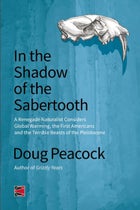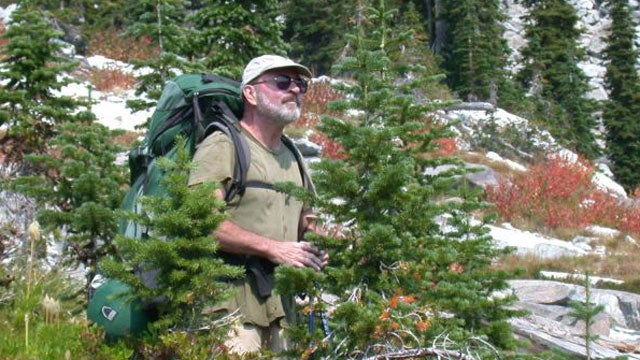Doug Peacock, well-known naturalist, grizzly researcher, writer, and inspiration for Ed Abbey’s character George Hayduke in The Monkey Wrench Gang, has turned his formidable literary chops to the subject of climate change and the kind of “Grand ���ϳԹ���” humans will be confronting in the wake of environmental collapse. His new book, (Counterpunch/AK Press, 2013), takes a deep and scientific look into our Pleistocene past in order to imagine what a post-climate-change future might look like. We caught up with him recently to hear more his latest work.

���ϳԹ���: Why did you decide to write this book?
When I decided to write this book, the cardinal issue of my generation was clearly the collective damage we’ve done to the planet, the shorthand we call Climate change, but, more accurately, global warming. The prognosis is grim, and it’s a real bummer story. I didn’t want to write a bummer book, so I wondered how to write around it in some instructive way. I have ancient degrees in paleontology, archeology, geology. I knew that modern humans have experienced two episodes of global warming—now and approximately 15,000 years ago when the great glaciers of the Pleistocene began to melt and the first humans showed up in North America. (There’s not a lot of hard evidence to pin down the dates, exactly.) It’s notable that by 40,000 B.C., humans had pioneered most every habitat on earth with the exception of North America, South America, and Antarctica. Something lurking in the Pleistocene bush might have kept them out of North America.
The wilderness those first Americans encountered is difficult to imagine: First, a landmass 5 times the size of Australia without a single human footprint, no smoke on the horizon, not a sign of an upright primate. Add to that the most amazing array of large animals anywhere—mammoths, mastodons, massive pack-hunting lions, Dire Wolves, American Cheetah (double the size of the African ones), and perhaps, most formidable of all, the short-faced bear. Imagine this animal 15 feet tall standing on its hind legs, flaring its nostrils, capable of smelling the carcass of a mammoth 20 miles away, a formidable problem for ancient hunters. I decided to tell that story. This involved more research than I’d ever done for any book. I read scientific papers for two years. Then I wrote for five years. It was the most serious commitment to a topic I’ve ever undertaken.
You talk about that time when our ancestors arrived in North America and faced all those animals that wanted to kill us, as the Greatest ���ϳԹ���. We talk about ���ϳԹ��� a lot nowadays. Nothing compares to that.
The notion of adventure involves risky undertakings, hazardous journeys, with uncertain outcomes. I call the colonization of America the Greatest ���ϳԹ��� because I love wilderness because that’s where true adventure takes place. You don’t always know what’s happening or how things turn out. Back then it was all as wild as the most remote mountain in North America.
Today we can manufacture our adventures: We structure rigorous routes and risky river crossings, and ‘hazardous journeys,’ but the ‘uncertain outcome’ is the real stickler. I was most interested in discovering any lessons to be learned from these Pleistocene hunters about adapting to changing climate. Are there useful comparisons with today’s crisis? Are we are going to recognize and adapt to the beast of our time—the beast that is global warming? This is not easy. A lack of hard data renders the comparison of the Pleistocene to today more parable than parallel. I feel that speculating into adaptation is important now because we’re facing a world that we’re not going to recognize in 15 years. It’s that simple.
Ice-age people coming to America crossed massive glaciers and treacherous rivers and faced huge, fearsome animals they’d never seen before, some who wanted to eat them. The Short-faced bear must have been terrible—a truly American beast that never crossed into Asia. Today’s adventure sports are a different thing. You can always quit and go home. You’re pretty sure of the outcome. These people didn’t know what they were going to run into. They didn’t know the country and they didn’t know the animals—unexpected outcomes were the norm. Today, we design modern adventures complete with magazine, book, and movie deals, vaguely hoping that something unexpected turns up, hopefully nothing fatal. This is something we still need…we still crave it. Back 15,000 years ago this was totally organic. Nothing was manufactured. It was part of daily life. Getting through each day embraced all shades of courage.
You said, “We still need this.” Why do you think that’s true?
Our Pleistocene odyssey has not yet ended and we’re about to enter an unfamiliar world. We haven’t finished this journey. We haven’t started to adapt to all the things we’ve done to the planet. The experience of adventure is pragmatic lore. The experience of wild living is an incredible survival tool. It’s natural to survive. We’re going to need those skills in the very near future.
Skills? For example?
Humility, mainly. We are not in charge. We humans don’t control our own fate. Accepting this is not unlike accepting wilderness. I used to go by myself into grizzly country for weeks at a time. Grizzlies instill a sense of humility better than anything I know in the world—with grizzlies you’re definitely not at the top of the food chain. You perceive the world differently. It’s a healthy perception. You sharpen your survival skills. You see and hear and smell better. It’s a rich way to live. We’re going to need some of that. It’s a very utilitarian perception of the world, the one anchored in humility. Which is also the emotional posture behind reason.
Wilderness is important, but how will it prepare us for this upcoming massive change?
Remnants of that habitat encountered by those first Americans are still around today and we call it wilderness. Wilderness is where all of our evolution took place. The human mind was shaped in the wilderness, by the mammoths we hunted and the sabertooths who hunted us. We need to keep great hunks of it around to remind us of that original experience, that perception of authentic risk. This is something lacking in modern people. We’re unable to accurately perceive what lies in our long-term interest for survival. Somehow we need to make the transition from perceiving the shadow of the sabertooth in the brush, which is an immediate peril, to being able to see, for example, the distant, incremental, and remote ocean rise, which could displace a billion starving strangers.
So what’s wrong with us? You talk in your book about the Clovis people, these amazing hunters with this amazing technology who may be responsible for mass extinctions. Why are we like that? We have technology but we lack restraint.
Remember, North America was experiencing climate change at the time. The Clovis people blasted down the ice-free corridor to Montana and ran into Mammoths and wanted to kill and eat one because that’s what their ancestors did 400-500 years before. They discovered stone quarries where they could create the incredible, iconic, magnificent fluted, 6- or 7-inch long “Clovis” spear point, a very effective weapon. The terminal dates of the classic megafauna overlap with the time of the Clovis people, who seemed to explode across the continent, almost as if they showed up everywhere at once. This brings up the dark question of the nature of the beast: Are we the homicidal brutes deservedly kicked out of Eden ready to duke or nuke it out to the end of the Earth? Or are we what we sometimes see ourselves as—the deeply sentient beings capable of the type of empathy that surviving this new, hot future will require?
If what you describe in your book is the last Great ���ϳԹ���, what’s the next Great ���ϳԹ���?
It’s not going to be fun. How about the future portrayed in modern sci-fi literature and films of a thug-like future run by warlords in the Arctic? This may not be so far off because that’s may be the only place one will be able to live.
This may not take a hundred years. It might take ten or 15. The polar ice caps are disappearing fast. Once they’re gone, things speed up; the Amazon collapses. Then the permafrost melts, releasing massive amounts of methane, adding another 6-7 degrees of global warming. In Antarctica, when the Ross Ice Sheet goes, oceans could rise 12 feet within a week—everywhere. That will get people’s attention. No one knows exactly what will happen. It’s like removing a top predator from an ecosystem and causing a cascading series of ecological collapses and disasters. No one can predict the effects. Surviving is not going to be fun but it will be an adventure.
Where’s your joy? What keeps you going these days?
Visiting a little pocket of what you and I would call wild country. I go to Yellowstone and leave the road and walk over a little hill and all of a sudden it’s like it was a thousand years ago. I look for bear tracks and watch the bison and any other critters who are there and, as this is available to me everyday, I take advantage of these pockets of wilderness where I live. And I go to Glacier and I visit my bears in the backcountry. That’s a little part of the world that is still as it always was and experiencing it generates joy. I don’t know of a combative weapon greater than the expression of joy. If we can find joy in our lives we can find the strength to fight back and come out of this thing. It’s our only chance. It’s worth the fight.


